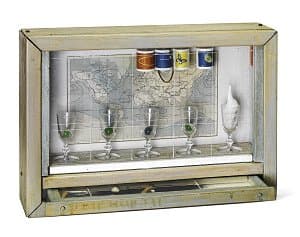

Joseph Cornell
Learn moreUntitled c.1950
© Joseph Cornell. VAGA/Copyright Agency Purchased 1973
More detail | PermalinkJoseph Cornell was acquainted with many émigré European artists, including a number of Surrealists who settled in or moved through New York. Their ideas inflect his work and his creations were, in turn, influential in introducing these ideas further afield. An avid collector, Cornell scoured Manhattan’s antique bookshops and second-hand stores for paper ephemera and small objects to make his signature glass-fronted boxes. His first box was shown in the Fantastic Art, Dada, Surrealism exhibition at the Museum of Modern Art, New York, in 1936. From his knowledge of European culture, art and literature the reclusive artist, who never travelled beyond New York, created his own microcosms, self-contained worlds in which to explore life hermetically.
Cornell admired the detail and finish of seventeenth-century Dutch still-life painting, referring to the genre as ‘ultra-graphic microscopic magic’.[1] The same precision and complexity applies to Untitled c#1950 from the Navigation series. The phrase ‘nostalgia of the sea’ occurs frequently in Cornell’s diaries, and was an emotion he hoped to crystallise in his work.[2] Washed with thin blue paint, as if scoured by seawater, the exterior paintwork of this box has a weathered look. An intriguing map occupies the back of the box, areas of which are washed with a light blue watercolour. On the underside of the box’s roof is a section of a German map showing an expanse of the Atlantic Ocean from the Caribbean to the United Kingdom. Cuttings from a guide to astronomy are attached to four suspended wooden cylindrical blocks. Five liqueur glasses stand in hollows cut into the wood at the bottom of the box—four contain a marble, the fifth holds a white spiral shell. The shallow white drawer is covered with a glass pane and contains a sprinkled mass of dark blue powder, metal ball-bearings, shells and strips of cork. Cornell has drawn a thin grid of white paint on the glass covering the drawer, inspired perhaps by the lines of latitude and longitude on the maps.
Lucina Ward[3]
[1] Undated diary entry, Joseph Cornell Papers (reel 1062, frame 878).
[2] See, for example: ‘nostalgia of the sea / we pick up a piece of wood on the seashore / there is infinite legend & romance about flotsam and jetsam—equivalent in mounting to retain this quality / immaculate aspect of something surviving a hundred years’. Joseph Cornell Papers, source material files I (reel 1067, frame 427).
[3] Adapted and updated from Michael Lloyd and Michael Desmond, European and American paintings and sculptures 1870–1970 in the Australian National Gallery, Australian National Gallery, Canberra, 1992, pp 224–5.

